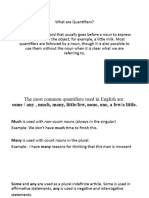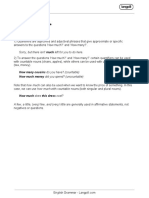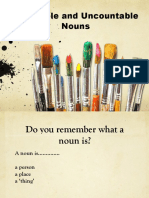1.1 10. (Textbook) Quantifiers - A Lot of - Most PDF
1.1 10. (Textbook) Quantifiers - A Lot of - Most PDF
Uploaded by
UDAYAN SHAHCopyright:
Available Formats
1.1 10. (Textbook) Quantifiers - A Lot of - Most PDF
1.1 10. (Textbook) Quantifiers - A Lot of - Most PDF
Uploaded by
UDAYAN SHAHOriginal Title
Copyright
Available Formats
Share this document
Did you find this document useful?
Is this content inappropriate?
Copyright:
Available Formats
1.1 10. (Textbook) Quantifiers - A Lot of - Most PDF
1.1 10. (Textbook) Quantifiers - A Lot of - Most PDF
Uploaded by
UDAYAN SHAHCopyright:
Available Formats
Quantifiers – a lot of – most
Langpill.com
Quantifiers – a lot of – most
Introduction
1) Quantifiers are adjectives and adjectival phrases that give approximate or specific
answers to the questions ‘How much?’ and ‘How many?’.
Sorry, but there isn’t much left for you to do here.
2) To answer the questions ‘How much?’ and ‘How many?’ certain quantifiers can be used
with countable nouns (chairs, apples), while others can be used with uncountable nouns
(tea, money). We use much with uncountable nouns and many with countable nouns.
Note that much and many are mainly used in interrogative and negative sentences.
How many cousins do you have? (countable)
How much money did you spend? (uncountable)
Note that in spoken English and informal writing when we want to indicate a large quality of
something we tend to use a lot, a lot of, lots of.
A lot m
eans very often or very much. It is used as an adverb. It often comes at the end of a
sentence and never before a noun.
My brother plays football a lot.
She’s a lot happier after quitting her job.
A lot of i s more formal than lots of. They both mean a large amount or number of people or
things and they can be used with plural countable nouns and with singular uncountable
nouns for affirmatives, negatives, and questions.
lot of money.
That’s a
There are a lot of great students here.
We’ve got l ots of things to do today.
We use the quantifier most to talk about quantities, amounts and degree. We can use it with
a noun (as a determiner) or without a noun (as a pronoun). We can also use it with
adjectives and adverbs to form the superlative.
English Grammar - Langpill.com
Quantifiers – a lot of – most
Langpill.com
We use most with nouns in the meaning the majority of. If there is no article, demonstrative
or possessive pronoun, we use most right before the noun.
Most tap water is drinkable.
When we are talking about the majority of a specific set of something, we use most of the +
noun.
Most cakes are sweet. (cakes in general)
The party was amazing. Kate made m ost of the cakes herself. (a specific set of cakes
at the party)
We can leave out the noun with most when the noun is obvious from the context.
ost bring food from home. (=most students)
Students can eat in the cafeteria but m
Short Story Dialogue
– I know that most teenagers like partying and going out with their friends but most of
my friends aren’t like that. We go to the theatres and museums a lot.
– That’s so interesting! What do you like the most about contemporary museums?
– Well, most people think that museums are really boring but it’s not true
nowadays. A lot of museums are interactive. They are entertaining, engaging, and
educational. And people of all ages have lots of fun in there!
English Grammar - Langpill.com
Quantifiers – a lot of – most
Langpill.com
Independent Practice - Quantifiers – a lot of – most
1) Fill in the gaps with a lot, a lot of, most.
a. My dad spends …...…..….. money on his hobbies.
b. …...…..….. of the children at this school have tablets.
c. Generally speaking, …...…..….. pizzas contain meat.
d. We had to write …...…..….. essays this semester.
e. I don’t like strawberries …...…..….. .
f. …...…..….. of the time I spend reading at home.
g. Peter looks …...…..….. younger than his brother.
h. Don’t worry, we have …...…..….. time to finish it!
i. There are …...…..…..smokers in their family.
j. …...…..….. taxis pass down this street, so you’ll be able to get home safely.
English Grammar - Langpill.com
Quantifiers – a lot of – most
Langpill.com
Independent Practice: Answers - Quantifiers – a lot of – most
1) Fill in the gaps with a lot, a lot of, most.
a. My dad spends a lot of money on his hobbies.
b. Most of the children at this school have tablets.
c. Generally speaking, most pizzas contain meat.
d. We had to write a lot of essays this semester.
e. I don’t like strawberries a lot.
f. Most of the time I spend reading at home.
g. Peter looks a lot younger than his brother.
h. Don’t worry, we have a lot of time to finish it!
i. There are a lot of smokers in their family.
j. A lot of taxis pass down this street, so you’ll be able to get home safely.
English Grammar - Langpill.com
You might also like
- 5.1 11. (Textbook) Present Simple PDFDocument4 pages5.1 11. (Textbook) Present Simple PDFUDAYAN SHAHNo ratings yet
- The Betfair Football Betting Systemv2Document10 pagesThe Betfair Football Betting Systemv2Alvin Jantjies100% (2)
- Approximating The Shapiro-Wilk W-Test For Non-NormalityDocument3 pagesApproximating The Shapiro-Wilk W-Test For Non-NormalityOsman HamdiNo ratings yet
- The Cambridge History of Jewish Philosophy Vol 1 PDFDocument899 pagesThe Cambridge History of Jewish Philosophy Vol 1 PDFG Maria Grigore100% (13)
- Quantifiers - Much - ManyDocument3 pagesQuantifiers - Much - Manyyunus karakasNo ratings yet
- I Need Some Pepper For This RecipeDocument12 pagesI Need Some Pepper For This RecipeNatalia Carolina CifuentesNo ratings yet
- A, An, Some Si AnyDocument10 pagesA, An, Some Si AnyRalucaVieruNo ratings yet
- A Lot of and Lots of PDFDocument2 pagesA Lot of and Lots of PDFDobreanu Bianca100% (2)
- Expression of QuantityDocument8 pagesExpression of QuantityGIYAN DWINo ratings yet
- Review Unit TestDocument12 pagesReview Unit TestGhinaNo ratings yet
- Ountable Nouns: A Dog Is An AnimalDocument9 pagesOuntable Nouns: A Dog Is An AnimalJoseMa AralNo ratings yet
- Makalah Countable and UncountableDocument21 pagesMakalah Countable and UncountableAlfa Ganjar100% (2)
- The Comparative and The SuperlativeDocument8 pagesThe Comparative and The SuperlativeWendyNo ratings yet
- 0 5 Jadwal Rencana Produksi1Document8 pages0 5 Jadwal Rencana Produksi1annisaNo ratings yet
- Quanti FiersDocument4 pagesQuanti FiersJacqueline Arevalo FríasNo ratings yet
- Nouns and ArticlesDocument37 pagesNouns and ArticlesArija EverdinNo ratings yet
- MuchDocument17 pagesMuchdaniloNo ratings yet
- Nouns and QuantifiersDocument4 pagesNouns and Quantifiersvvhiip0% (1)
- Ingles Tarea 3Document4 pagesIngles Tarea 3Mariela Ortiz CepedaNo ratings yet
- Tugas Bahasa InggrisDocument6 pagesTugas Bahasa InggrisHar LinawatiNo ratings yet
- Noun 221219 164053Document22 pagesNoun 221219 164053Ahmad MuridNo ratings yet
- Módulo 3 Grammar and BusinessMomentDocument12 pagesMódulo 3 Grammar and BusinessMomentEstevãoEduardoCherengaNo ratings yet
- GrammarDocument2 pagesGrammarស្រមោល កំណាចNo ratings yet
- Countable and Uncountable NounsDocument7 pagesCountable and Uncountable NounsValentine NNo ratings yet
- 1.1 8. (Textbook) Quantifiers - A Few - A Little PDFDocument4 pages1.1 8. (Textbook) Quantifiers - A Few - A Little PDFUDAYAN SHAHNo ratings yet
- Countable and Uncountable NounsDocument18 pagesCountable and Uncountable NounsMX CreationNo ratings yet
- Pref - 1 - Grammar 3.1 PDFDocument3 pagesPref - 1 - Grammar 3.1 PDFElver HUERTAS RAMIREZNo ratings yet
- Count and NonCount NounsDocument19 pagesCount and NonCount NounsBerna GüzelderenNo ratings yet
- Difinition Grammar Unit 5 Core English 1A&1BDocument7 pagesDifinition Grammar Unit 5 Core English 1A&1Bpanhakol306No ratings yet
- Helping Verbs in EnglishDocument23 pagesHelping Verbs in EnglishVaibhav SattikarNo ratings yet
- Edx Speaking Short Note PDFDocument10 pagesEdx Speaking Short Note PDFLily LaurenNo ratings yet
- SUMMARY OF EXHIBITIONS FOR THE 3rd PARTIAL GOT 4Document16 pagesSUMMARY OF EXHIBITIONS FOR THE 3rd PARTIAL GOT 4fabioladelpilarcolquecondori3No ratings yet
- Grammar Review For The Midterm ExamDocument9 pagesGrammar Review For The Midterm ExamJuan Camilo HiguitaNo ratings yet
- Lesson 3, Tobe, Little, FewDocument14 pagesLesson 3, Tobe, Little, FewKharesti Ulva SeptaNo ratings yet
- 159 Difficult Words To Pronounce in English 1Document8 pages159 Difficult Words To Pronounce in English 1Final 22No ratings yet
- Non-Count Nouns: Amount and How Much Refer To Non-Count Nouns While Number and How Many Refer To Count NounsDocument8 pagesNon-Count Nouns: Amount and How Much Refer To Non-Count Nouns While Number and How Many Refer To Count NounsJakaria SajaNo ratings yet
- Destination B1 Unit 13 14 15Review-B1 KeyDocument13 pagesDestination B1 Unit 13 14 15Review-B1 KeyY DươngNo ratings yet
- Some - Any - A Little - A Few - Much - ManyDocument3 pagesSome - Any - A Little - A Few - Much - ManyAlfonso MartinezNo ratings yet
- Presentation (Count, Noncount)Document33 pagesPresentation (Count, Noncount)kuanzc100% (1)
- Countable Nouns and Uncountable NounsDocument3 pagesCountable Nouns and Uncountable NounsValdo José SumalNo ratings yet
- Learning Activity 4Document8 pagesLearning Activity 4FatrisNo ratings yet
- Use of Some and Any: Study The Following TablesDocument7 pagesUse of Some and Any: Study The Following Tablesakhilesh sahooNo ratings yet
- Тема 2. Countable and Uncountable NounsDocument36 pagesТема 2. Countable and Uncountable NounsКравець Руслан Андрійович ВНАУNo ratings yet
- Week11 PDFDocument37 pagesWeek11 PDFVanesa GomezNo ratings yet
- Much Many A Lot ofDocument3 pagesMuch Many A Lot ofAlex Nikovski100% (1)
- Termas de InglesDocument22 pagesTermas de Inglesjairo.palaciosNo ratings yet
- Quanti FiersDocument4 pagesQuanti FiersValeska SandovalNo ratings yet
- A Lot /much/ Many: B. We Use Much in Questions and Negative Sentences. We Do Not NormallyDocument3 pagesA Lot /much/ Many: B. We Use Much in Questions and Negative Sentences. We Do Not NormallyRosanna BellaubiNo ratings yet
- Grammar Countable An Uncountable NounsDocument7 pagesGrammar Countable An Uncountable NounsEstefania Osorio RiañoNo ratings yet
- Topic: Quantifiers: With Count Nouns Only With Uncount Nouns Only With Both Count and Uncount NounsDocument7 pagesTopic: Quantifiers: With Count Nouns Only With Uncount Nouns Only With Both Count and Uncount NounsbrifaniobumbaNo ratings yet
- Topic: Quantifiers: With Count Nouns Only With Uncount Nouns Only With Both Count and Uncount NounsDocument4 pagesTopic: Quantifiers: With Count Nouns Only With Uncount Nouns Only With Both Count and Uncount NounsbrifaniobumbaNo ratings yet
- De Cuong On Tap HK6Document5 pagesDe Cuong On Tap HK6Kendrick PriceNo ratings yet
- Quantifiers 1 Grammar Drills Grammar Guides 49243Document2 pagesQuantifiers 1 Grammar Drills Grammar Guides 49243ZETI AKHTAR BINTI ADNAN MoeNo ratings yet
- Unit 1 PET GrammarDocument6 pagesUnit 1 PET GrammarPabloNo ratings yet
- Apuntes JobsDocument12 pagesApuntes JobsMAIKE BELEN LUCAS BOHORQUEZNo ratings yet
- Idioma Extranjero Ingles I: Docente: Fabiola Damiani Maquito AREQUIPA - 2021Document16 pagesIdioma Extranjero Ingles I: Docente: Fabiola Damiani Maquito AREQUIPA - 2021Alberto HuamaniNo ratings yet
- TGFR DemoDocument33 pagesTGFR DemoCristine Joyce LucasNo ratings yet
- Countable Nouns, Handling Any RequestDocument34 pagesCountable Nouns, Handling Any RequestKomang SriNo ratings yet
- Grammar 1 (Countable and Uncountable Nouns (Much Many)Document38 pagesGrammar 1 (Countable and Uncountable Nouns (Much Many)Kim Nicole SánchezNo ratings yet
- Many Much Few LittleDocument4 pagesMany Much Few LittleAnonymous Ybwg9CNo ratings yet
- Present Perfect Continuous With "How Long"Document9 pagesPresent Perfect Continuous With "How Long"اسامه محمدNo ratings yet
- Session 5 - Countable - UncountableDocument16 pagesSession 5 - Countable - UncountableAngelica Lutter David LoboNo ratings yet
- Worksheet 8A-8BDocument13 pagesWorksheet 8A-8BRuddy Carrillo RojasNo ratings yet
- English Verb Tenses: Practice and Speak Like a NativeFrom EverandEnglish Verb Tenses: Practice and Speak Like a NativeRating: 5 out of 5 stars5/5 (1)
- Leadership and Change Management: BITS PilaniDocument30 pagesLeadership and Change Management: BITS PilaniUDAYAN SHAHNo ratings yet
- Leadership and Change Management: BITS PilaniDocument51 pagesLeadership and Change Management: BITS PilaniUDAYAN SHAHNo ratings yet
- BITS Pilani: Leadership and Change Management Date: 3/2/18Document38 pagesBITS Pilani: Leadership and Change Management Date: 3/2/18UDAYAN SHAHNo ratings yet
- Pre Mid Term Revision: Leadership and Change ManagementDocument57 pagesPre Mid Term Revision: Leadership and Change ManagementUDAYAN SHAHNo ratings yet
- Leadership and Change Management: BITS PilaniDocument30 pagesLeadership and Change Management: BITS PilaniUDAYAN SHAHNo ratings yet
- 1.1 19. (Textbook) Modal Verbs - Shall - Should PDFDocument4 pages1.1 19. (Textbook) Modal Verbs - Shall - Should PDFUDAYAN SHAHNo ratings yet
- Leadership and Change Management: BITS PilaniDocument37 pagesLeadership and Change Management: BITS PilaniUDAYAN SHAHNo ratings yet
- Leadership and Change Management: BITS PilaniDocument29 pagesLeadership and Change Management: BITS PilaniUDAYAN SHAHNo ratings yet
- 1.1 18. (Textbook) Modal Verbs - Must - May - Might PDFDocument4 pages1.1 18. (Textbook) Modal Verbs - Must - May - Might PDFUDAYAN SHAHNo ratings yet
- Leadership and Change Management: BITS PilaniDocument58 pagesLeadership and Change Management: BITS PilaniUDAYAN SHAHNo ratings yet
- 1.1 20. (Textbook) Modal Verbs - Will - Would PDFDocument4 pages1.1 20. (Textbook) Modal Verbs - Will - Would PDFUDAYAN SHAHNo ratings yet
- Leadership and Change Management: BITS PilaniDocument46 pagesLeadership and Change Management: BITS PilaniUDAYAN SHAHNo ratings yet
- 1.1 21. (Textbook) Limiting Adjectives PDFDocument4 pages1.1 21. (Textbook) Limiting Adjectives PDFUDAYAN SHAHNo ratings yet
- 1.1 25. (Textbook) Adverbs of Frequency PDFDocument4 pages1.1 25. (Textbook) Adverbs of Frequency PDFUDAYAN SHAHNo ratings yet
- 5.1 16. (Textbook) Present Continuous PDFDocument4 pages5.1 16. (Textbook) Present Continuous PDFUDAYAN SHAHNo ratings yet
- 1.1 15. (Textbook) Past Continuous PDFDocument4 pages1.1 15. (Textbook) Past Continuous PDFUDAYAN SHAH100% (1)
- 1.1 8. (Textbook) Quantifiers - A Few - A Little PDFDocument4 pages1.1 8. (Textbook) Quantifiers - A Few - A Little PDFUDAYAN SHAHNo ratings yet
- 1.1 12. (Textbook) Distributives - Both - Either - Neither PDFDocument4 pages1.1 12. (Textbook) Distributives - Both - Either - Neither PDFUDAYAN SHAHNo ratings yet
- 5.1 5. (Textbook) Abstract Nouns PDFDocument4 pages5.1 5. (Textbook) Abstract Nouns PDFUDAYAN SHAHNo ratings yet
- 1.1 1. (Textbook) Material and Compound Nouns PDFDocument4 pages1.1 1. (Textbook) Material and Compound Nouns PDFUDAYAN SHAHNo ratings yet
- 1.1 4. (Textbook) Concrete Nouns PDFDocument4 pages1.1 4. (Textbook) Concrete Nouns PDFUDAYAN SHAHNo ratings yet
- 13.1 13. (Textbook) Future Simple PDFDocument3 pages13.1 13. (Textbook) Future Simple PDFUDAYAN SHAHNo ratings yet
- 1.1 3. (Textbook) Collective Nouns PDFDocument4 pages1.1 3. (Textbook) Collective Nouns PDFUDAYAN SHAHNo ratings yet
- 1.1 20. (Textbook) Proper Adjectives PDFDocument3 pages1.1 20. (Textbook) Proper Adjectives PDFUDAYAN SHAHNo ratings yet
- Reverse BrainstormingDocument12 pagesReverse Brainstorminghemang.shroffNo ratings yet
- Biomimetic Materials in Dentistry 2321 6212 1000188Document9 pagesBiomimetic Materials in Dentistry 2321 6212 1000188Bhoomika SikriNo ratings yet
- AashtoDocument2 pagesAashtophanna100% (1)
- Medicine Simplified DBMCI: To Get More Content Like This Join Our Telegram GroupDocument8 pagesMedicine Simplified DBMCI: To Get More Content Like This Join Our Telegram GroupAnisa Osman HassanNo ratings yet
- Test 4A: © Pearson Longman 2007Document5 pagesTest 4A: © Pearson Longman 2007saANo ratings yet
- Salient Features of Modern LinguisticsDocument5 pagesSalient Features of Modern LinguisticsAbdul Samad100% (1)
- The Right To A Balanced and Healthful Ecology by Antonio G.M. La ViñaDocument30 pagesThe Right To A Balanced and Healthful Ecology by Antonio G.M. La Viñaellen joy chanNo ratings yet
- Mayo V SatanDocument2 pagesMayo V SatanRix MigriñoNo ratings yet
- 8 Profit Activators - Joe Polish Dan KennedyDocument33 pages8 Profit Activators - Joe Polish Dan KennedyRJ100% (1)
- List of Society Latest PDFDocument42 pagesList of Society Latest PDFDr Tilak Raj MeenaNo ratings yet
- 01204427-Modes of OperationDocument38 pages01204427-Modes of OperationSwati SharmaNo ratings yet
- Birla Institute of Technology and Science, Pilani Pilani Campus AUGS/ AGSR DivisionDocument4 pagesBirla Institute of Technology and Science, Pilani Pilani Campus AUGS/ AGSR DivisionPriyam VermaNo ratings yet
- Ashtanga Yoga PosesDocument25 pagesAshtanga Yoga PosesadrianstanroNo ratings yet
- Application of Taguchi Method in Optimization of Gate Oxide and Silicide Thickness For 45nm NMOS DeviceDocument5 pagesApplication of Taguchi Method in Optimization of Gate Oxide and Silicide Thickness For 45nm NMOS DeviceMaizan MuhamadNo ratings yet
- Reiner Schurmann Tomorrow The Manifold Essays On Foucault Anarchy and The Singularization To Come 5 PDF FreeDocument185 pagesReiner Schurmann Tomorrow The Manifold Essays On Foucault Anarchy and The Singularization To Come 5 PDF FreeDavid Iván Ricardez FriasNo ratings yet
- Business Administrator Resume Objective SampleDocument7 pagesBusiness Administrator Resume Objective SampleZhaine CeradoNo ratings yet
- Republic Vs HidalgoDocument2 pagesRepublic Vs HidalgoIñigo Mathay Rojas100% (4)
- Thesaurus Precum LatinarumDocument24 pagesThesaurus Precum LatinarumCarlos FlammenschwertNo ratings yet
- Contemp. Arts Module 4Document25 pagesContemp. Arts Module 4Richard JR LayaguinNo ratings yet
- The Age of Surveillance Capitalism TextDocument7 pagesThe Age of Surveillance Capitalism TextwadnermanNo ratings yet
- Virtual LaboratoryDocument14 pagesVirtual LaboratoryArie Febry Fardheny, MTNo ratings yet
- Soul WinningDocument8 pagesSoul WinningCharlize Fernandez100% (1)
- Lesson 2Document7 pagesLesson 2CharityOriaNo ratings yet
- PHASE I (The Outline of The Foundation) (4-5 Weeks)Document3 pagesPHASE I (The Outline of The Foundation) (4-5 Weeks)AhmadNo ratings yet
- 6 Essential Skills For Reading ComprehensionDocument5 pages6 Essential Skills For Reading ComprehensionSaleem Raza100% (1)
- Shakespare ComedyDocument34 pagesShakespare ComedySamuel DavisNo ratings yet
- Chemistry Lesson #1 - The Kinetic Particle Theory Pre-Test!Document6 pagesChemistry Lesson #1 - The Kinetic Particle Theory Pre-Test!estherlimrhNo ratings yet

















































































































